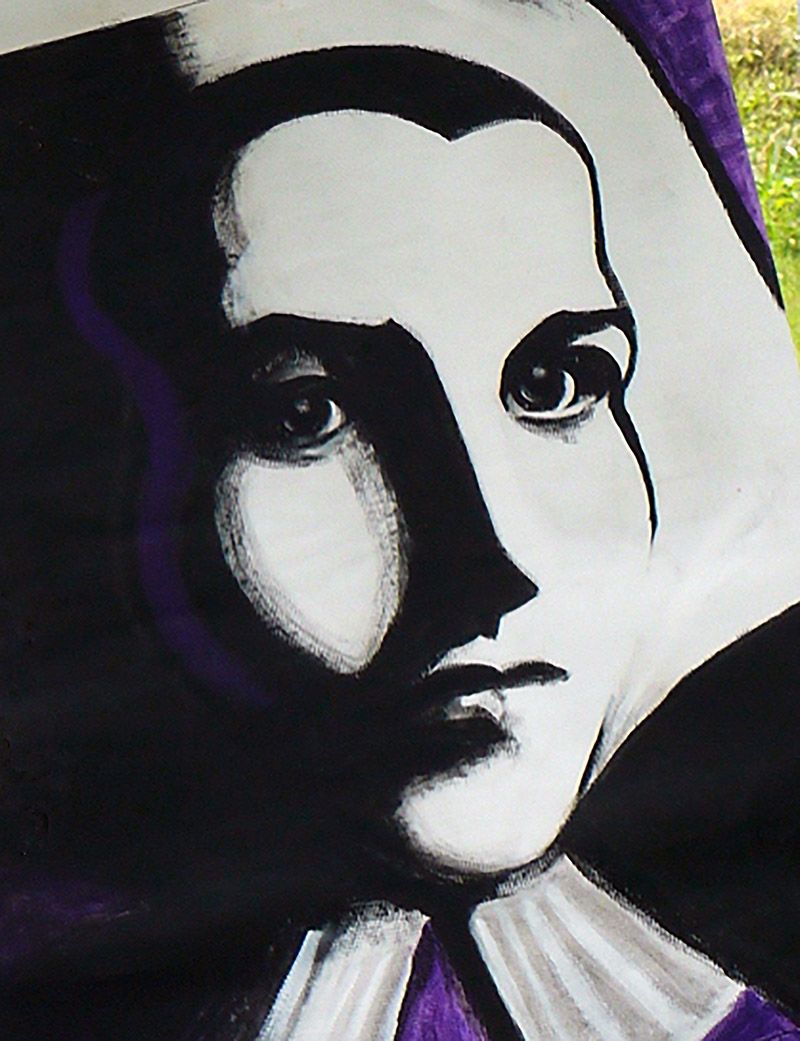Anne Hutchinson
Anne Marbury Hutchinson, the daughter of a minister, was born in Alford, England around July 1591. Growing up in Alford and London, she learned from her mother how to take care of the sick, treat wounds, make remedies, and tend to women in childbirth. Anne would continue these roles of healer and midwife throughout her life. She could not go to school like her brothers, but her father taught her about the bible and religious beliefs. In 1612, Anne married William Hutchinson, an Alford cloth merchant and farmer, and the couple made their home in Alford. They became inspired by the Puritan minister John Cotton, who in 1633 moved to the Massachusetts Bay Colony to avoid persecution by the Church of England. The following year the Hutchinson family moved to the Bay Colony as well, fearing both the plague, which had taken the lives of two of their children, and persecution for their Puritan beliefs.
The ministers of Boston viewed Anne as a threat to their power and to the community. Anne’s greatest crime was leading weekly public meetings to discuss scripture, theology, and the ministers’ sermons. In 1635, only women attended her meetings, but by 1636 men began to accompany their wives. Anne was put on trial twice - a civil trial in the fall of 1637, and a church trial in March of 1638.
Among her followers were men who would become some of Portsmouth’s prominent town founders. Many of them were solid citizens in Boston. As Anne was tried in court, her followers were removed from positions in town government, deprived of their weapons, and expelled from Boston. The men in Hutchinson’s group wanted to create a settlement with freedom of conscience. Roger Williams, who had been expelled from Boston earlier, urged them to try Aquidneck Island. Men packed building supplies in a ship they had hired to sail them around Cape Cod. About March 7th, 1638, while in Boston, a group of men signed what is now known as the Portsmouth Compact. It was an agreement to join together as a “Bodie Politik.” Anne’s husband and her son Edward traveled to Providence to see Roger Williams who arranged a meeting with Narragansett Sachems Miantonomi and Canonicus. On March 24th, they gave the Sachems “a gratuity” of forty fathoms of white wampum beads, ten coats, and twenty hoes. The men continued south on ships to a new home, Aquidneck Island in Narragansett Bay. They agreed to make the first settlement on the flat northeastern end, which had a natural spring saltwater cove. Very little is known about Anne’s life in Portsmouth, where she lived for the next four years.
When her husband William died, Boston leaders were prepared to intimidate Anne again. Ministers from Boston came and suggested they would take over Rhode Island. Without William, Anne was vulnerable. She began to move from Portsmouth to New York in 1642. Her furniture and heavy belongings were sent over land along with horses, cattle, and hogs. She hired boats to transport her group of family and friends to a new home in the Dutch colony of East Chester, New York. In August of 1643, Anne and most of her family were butchered in an attack by the Siwanoy tribe. Her daughter Susanna, the only survivor of the attack, was taken captive and held by the tribe for several years.
Biography and image provided by Portsmouth Historical Society
